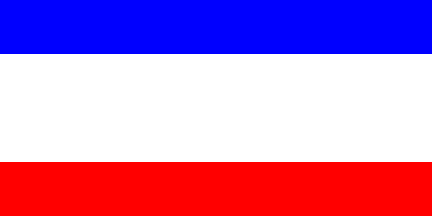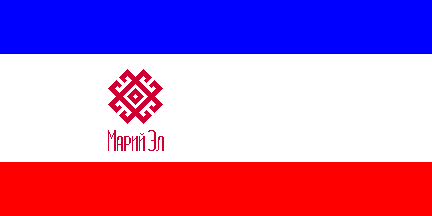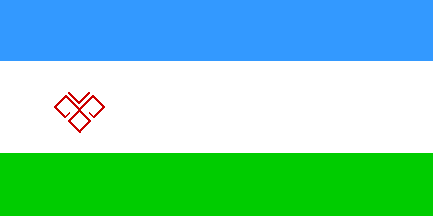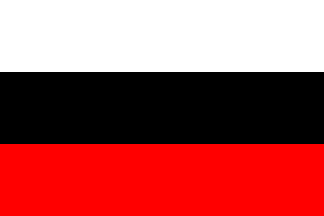
image by Željko Heimer, 11 May 1996 |

Last modified: 2006-07-29 by antonio martins
Keywords: mariy-el | sun: 4 rays | error | different reverse | law | tisten | bulygin (g. n.) | kazakov (v. g.) | danilov (a.) | clay | national ornament | ethnic |
Links: FOTW homepage |
search |
disclaimer and copyright |
write us |
mirrors

(Note: You need an Unicode-aware software and font to correctely view the cyrillic text on this page. See here transliteration details).
Like Komi, Mari are Finnic.
"Mari" means "men"; they call their land
Marintasavalta (land of men).
Giuseppe Bottasini, quoting
[zig94]
The ancestors of the Mari used a banner, but nothing is known about it
except its name, Tisten.
Ivan Sache, 30 Apr 2000
According the Resolution relative to the flag and the coat of arms of the Republic of Marii-El of the 3rd of September 1992, the flag has three horizontal stripes (1:2:1), the first is blue, the second is white and the third is red. On the white stripe, at a distance to the hoist equal to the width of this white stripe, there is a local ornament (a stylised sun) and under, the name of the Republic in cyrillic letters:
Марий Эл
The sun and the letters are dark red. The colours blue, white and
red remind the colours of the Russian flag. The
ornament is a stylised sun, also the eternity, fertility, life. This
dark brown red colour reminds the fact that in Marii El legends, it is
said that life originally came from brown clay [see also the Bible].
Pascal Vagnat, 13 Sep 1997, quoting from
[cdd]
The flag was designed by G. Bulygin and A. Danilov. In original russian text
of the Law the colours of flag are «azure, white and scarlet». As you know they
are the official colours of russian flag before 1993.
Mariy El copied the russian colour names for their own flag law.
Victor Lomantsov, 01 May 2000
According to Jiři Tenora [jtn02] the
sun symbol on the flag of Mordovia is divided into four parts symbolizing the
four Mordovian tribes.
Ivan Sache, 18 Apr 2002
I wonder which four tribes these are — Mordovians are not an
ethno-linguistically homogenous groups, that is sure, but the main
division is twofold: Mokshians and Erzians, and these are diverse enough
from each other, and enough homogenous within, to make any subdivision
of these two groups look inimportant comparing with the primary
division.
António Martins, 07 May 2002
The fragment of the national ornament has two meanings: it represents
the an archaic element of the rural civilisations (a stylized sun, source
of fecundity, life and eternity) and its reddish brown colour refers to a
very ancient legendf of the Mari people. Life on earth is said to have
stemmed from brown clay. The supreme god Kugu-Jumo gave it to his junior
brother, who swam as a bird in the primordial ocean.
Ivan Sache, 30 Apr 2000, based on
[jtn99]
Judging from the text of the law, it seems that
the use of the flag is rather restricted and that there is no “civil”
flag for private use.
Ivan Sache, 30 Apr 2000
The law section about flag usage (par. 3 bellow)
is virtually identical to any other russian subnational flag law — thus
unrestricted, even if seldom, usage by private citizens is to be expected.
António Martins, 04 Jun 2000
Confirmed by decision of the Supreme Council of the Republic of Mariy-El, #368-III of 3 September 1992translated by Ivan Sache, 30 Apr 2000, from [jtn99]Decree about the state flag of the Republic of Mariy-El
- The state flag of the Republic of Mariy-El is a state symbol of the Republic of Mariy-El.
- The state flag of the Republic of Mariy-El is made of a rectangular field with three horizontal stripes: the upper stripe is azure blue and its width is 1/4 of the flag width, the middle stripe is white and its width is 1/2 of the flag width, the lower stripe is red and its width is 1/4 of the flag width. The length of the flag is related to its width by a ratio of 2:1. In the left half of the white stripe, near to the flag hoist, is represented a fragment of a Mari national ornament. It is inscribed in a square, whose side equals 1/4 of the flag width. Below is the writing MARIY EL. The emblem and the inscription are reddish brown. The distance between the geometrical center of the ornament and the hoist is 1/2 of the flag width. The distance between the geometrical center of the ornament and the lower edge of the blue stripe is 1/5 of the flag width. The thickness of the lines of the ornament is 1/50 of the flag width. The writing MARIY EL is inscribed in a rectangle, whose sides equal 1/4 and 1/10 of the flag width. The rectangle is placed below the ornament 1/20 of the flag width from the upper edge of the red stripe. The height of the small capital letters is 3/4 the height of the normal capital letters. The lines constituting the letters have a thickness of 1/10 of the height of the small capitals. [See construction sheet bellow — ed.]
- The state flag of the Republic of Mariy-El should be hoisted:
- on the buildings in which the President of the Republic of Mariy-El, the Supreme Council of the Republic of Mariy-El, the Government of the Republic of Mariy-El, the local Councils of the People’s Deputies and the Supreme Chiefs of the Administration are housed — permanently.
- on the buildings in which the sessions of the Supreme Council of the Republic of Mariy-El and the local Councils of the People’s Deputies take place — during the entire duration of the session.
- on the buildings of the Ministeries, State Boards, Administrations and other state organisms of the Republic of Mariy-El, as well as on houses for feast and memorial days.
The state flag of the Republic of Mariy-El may occasionnaly be hoisted during ceremonies and other festivities organized by state organisms or social organizations. When the flags of the Russian Federation and the Republic of Mariy-El are hoisted together, both must be exactly at the same height. A sketch of the state flag of the Republic of Mariy-El is represented on the chest badge of the People’s Deputies of the Republic of Mariy-El and of the local Councillors of the People’s Deputies. The state flag of the Republic of Mariy-El and its representations must, regardless of the size, match exactly the colour and black-and-white illustrations attached to this decree.

 image by Željko Heimer, 11 May 1996 | |
Nothing is said about the reverse side of flag in the text
of the law. But when the law on flag was published in main newspapers in
Mariy-El, it was accompanied with two drawings (I have this newspaper): averse
and reverse of the flag. Reverse is without the emblem.
Victor Lomantsov, 01 May 2000
There are no letterings nor sun on the reverse
of the flag, there is nothing on the white stripe.
This flag is one of the rare flags to have an
obverse different from the
reverse.
Pascal Vagnat, 13 Sep 1997 and 28 Mar 1999
See also: Incorrect reverse in use
Projects for new symbols of the republic are currently under preparation,
because the current symbols do not abide some hrealdry rules (information
sent by cheif heraldist Izmail Efimov, creator of the new symbols).
Dmitriĭ Ivanov (webmaster,
Mariy-El gov site), 15 Aug 2001
The information about revsion of the arms (and flag?) by the russian State
Herald is particularly important. I’m personally afraid of the result, as
russian central heraldry authorities has shown as unimaginative, rigid and
vexillologically unaware as in many other countries.
António Martins, 29 Aug 2001

Bulygin and Kazakov designed first version: light-blue, white, green.
Victor Lomantsov, 01 May 2000
Tenora [jtn99] also shows an early proposal by G. N. Buligin and W. G. Kasakow. This flag never existed but was published as proposal by local media. It is a 1:2 flag, horizontally divided light blue - white - green (2:3:2). A simplified version of the national ornament is placed in the white stripe near the hoist. Blue symbolizes the sky but also the waters of the primordial ocean of the legend. White symbolizes the purity of the aims of the Mari people, the clothes for ceremonial days, and peace. Green symbolizes the places of worship and the ceremonies of the ancestors.
The ancestors of the Mari used a banner, but nothing is known about it except its name, Tisten. Therefore, the creation of national symbols for Mariy-El had to start from scratch. Initial proposals should have used reddish brown, yellow and white, according to the ethnographists W. A. Akzorin and I. W. Jefimow. Symbolic of reddish brown and white is explained above. Yellow is associated to the sun, according to a belief common in several finno-ugrian peoples: the sun initially constituted the yolk of the universe. The egg had been laid by the sky goddess Ilmatayurt (as a duck). The planets were later formed from her other eggs.
Ivan Sache, 30 Apr 2000
.gif)
The coat-of-arm shows the same device on a golden shield, with ears
of wheat, oak leaves and pine needles, all tied by the
national [maryan] colors.
Giuseppe Bottasini, quoting
[zig94]
It strikingly resambles the soviet russian
emblem (and consequentely the soviet
maryan emblem).
António Martins, 23 Nov 2002

In the number 2/2001 of Alkukoti I found an interesting map chart
[alk01] with the living areas and flags
of the different Finno-Ugric peoples. It shows a white-black-red flag for
the Mari.
Marco Pribilla, 02 Feb 2002
Anything below this line was not added by the editor of this page.